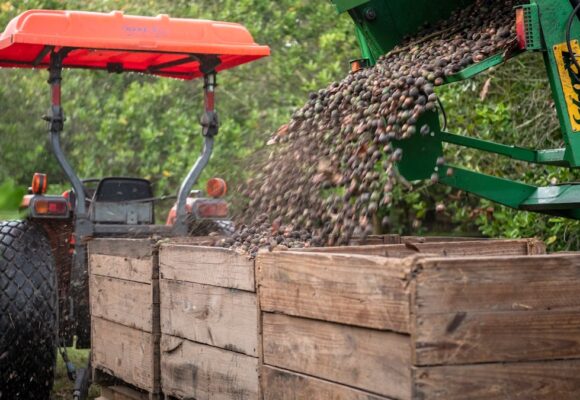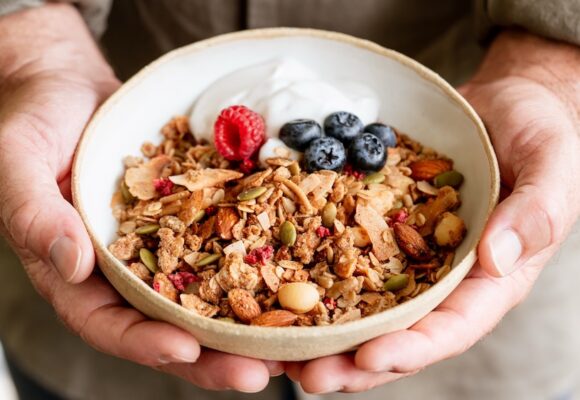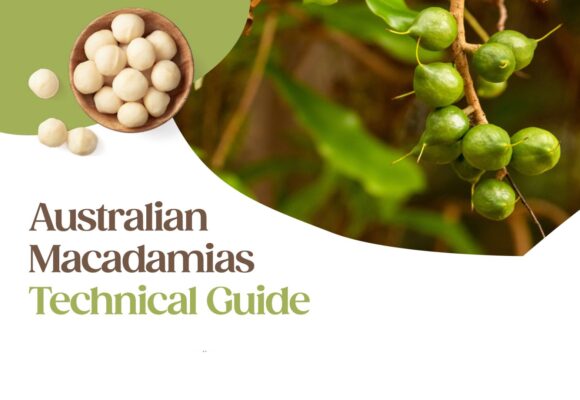
The popularity of nuts has soared in recent years as understanding of their health benefits expands, and consumers embrace the taste and texture they bring to snacks, home cooking and manufactured food products.
Nuts are packed with nutrients, and research shows regular nut consumption is associated with a wealth of health benefits, including significant reductions in coronary heart disease and cardiovascular disease risk 1-3 as well as reduced risk of stroke and type 2 diabetes. 1,2, 4-6
The well-known PREDIMED study7 examined the effects of a Mediterranean diet with and without nuts and found that including a daily serve of nuts in the diet reduced the composite risk of myocardial infarction, stroke or death from a cardiovascular cause by 28%.
Nut consumption is also associated with improved endothelial function,8,9 improvements in chronic inflammation,8-10 and emerging research suggests eating nuts may favourably impact the gut microbiome. 11-13
Yet most people still aren’t eating enough nuts, with a recent narrative review examining the barriers and facilitators of nut consumption14 highlighting that despite promotion of nut consumption in dietary guidelines around the world, nut intake is well below recommended levels.
So what sits between consumers’ current behaviour and the recommendations they’re ignoring, and how do we bridge that gap?
Here we examine three of the most common barriers to regular nut consumption, debunk some misconceptions and highlight the opportunities these present to help close the gap between current and recommended consumption levels.
Barrier #1: Confusion around fat content and weight management
Nuts are an energy-dense food due to their high fat content. The primary fats in nuts are the favourable unsaturated kind (monounsaturated and polyunsaturated fats) that support good health. Macadamias are the number one nut source of monounsaturated fat. But despite a general shift away from the low fat diet messaging of decades past and promotion of the concept of ‘good’ and ‘bad’ fats, confusion remains, and it appears to be affecting consumer behaviour worldwide.
- A survey of nut perceptions among Australian consumers revealed that 15-25% believe that consuming nuts does result in weight gain, 62% agreed that if eating nuts were to make them consume too much fat, then they would avoid nuts and nut butters, but 70% said they would increase their consumption of nuts and nut butters if this helped them get the right balance of good fats15
- A cross-sectional survey in New Zealand revealed one of the top reasons for avoidance of nut butters was the perception that they’re unhealthy and high in fat16
- In the USA, 87% of people with or at risk of cardiovascular disease and/or type 2 diabetes believed that eating nuts would trigger weight gain17
So what does science say? According to the narrative review, there is no evidence to suggest that eating nuts causes weight gain. 18, 19, 20 In fact, the opposite is true, with some evidence indicating that habitual nut consumption is associated with favourable effects in people who are overweight,21 particularly if nuts are being eaten in place of other foods in the diet.

In terms of how nuts can help to support healthy body weight, there are multiple mechanisms at play:
- The metabolisable energy in nuts is thought to be between 5% and 30% lower than conventional energy estimates22-25
- The fibre and protein content of nuts makes them a very satiating food26
- Emerging evidence suggests that eating nuts can help support improvement in overall diet quality8, 27
The opportunity: It appears that for many consumers, the idea of an energy-dense food being weight friendly is still counter-intuitive. The narrative review identifies an opportunity to educate consumers on the favourable fat profile of nuts, and the effects of nut intake on body weight to help consumers embrace nuts and products that contain them as part of their regular diet.
Barrier #2: Dental issues making nut consumption uncomfortable
Dentition issues can make it inconvenient or uncomfortable to eat nuts in kernel form, and a survey of Australian health professionals suggests this is a common concern, with more than half reporting their clients say that their dental issues make nut consumption problematic.17 Similar findings were reported in other countries too.
The opportunity: Nuts can be enjoyed in a variety of formats. Whether they’re chopped, in a paste or a flour, nuts provide essential nutrients, so there’s an opportunity to encourage consumption of less challenging formats among this group of consumers.

Barrier #3: Nut allergy concerns
Avoidance of nuts and nut products is essential and the only treatment for those with a diagnosed nut allergy, and it’s a space in which knowledge and medical advice continues to evolve.
Surveys of health professionals in Australia and New Zealand revealed that the presence of a nut allergy was a common barrier for nut intake reported by clients. However the percentages reported (up to 15%) exceeded the prevalence of peanut and tree nut allergy reported in medical literature, where estimates range from less than 1% up to 4%. This may suggest some people are inaccurately self-reporting nut allergies.
As a country with some of the highest food allergy rates in the world, researchers in Australia are leading a worldwide shift in the way food allergies are managed, in the hope of stemming the rise in the number of children affected. The Australasian Society of Clinical Immunology and Allergy now recommends27:
- Introducing foods according to what the family usually eats, regardless of whether the food is considered to be a common food allergen, at around 4-6 months of age. This can include nut butters, pastes and flours.
- Not excluding any particular food (including foods considered to be highly allergenic) during pregnancy or whilst breastfeeding as this has not been shown to prevent allergies
- Avoidance of blanket bans on particular foods in schools
The opportunity: Continued consumer education and reassurance around latest allergy research and advice is important, particularly among millennials who grew up in an era where nuts were largely avoided and are subsequently unsure whether it’s safe to incorporate nuts into their diets. The narrative review also highlights the opportunity for further research to explore whether those without medically diagnosed allergies are unnecessarily avoiding some foods.
Why the time is right to break down the barriers
There is significant unrealised global potential in terms of daily nut consumption, and arguably consumers have never been more attentive when it comes to health messaging.
60% of consumers worldwide state that they are more conscious about their overall health and wellbeing as a result of COVID-1928 and according to Mintel, the pandemic has put health front and centre of people’s everyday lives, stating in its 2021 Global Consumer Trends Report, “As consumers move forward beyond the pandemic, they will experience a new type of gratitude for what it means to have a healthy body.”
Understanding some of the barriers that are currently limiting consumers’ intake can help to guide strategy and messaging for nut industries, and brands embracing nuts as a rich nutrient, taste and texture addition to their products. With this knowledge and consumers’ current pursuit of optimum wellbeing, the stage is set to help more consumers than ever discover the benefits of a healthy handful of nuts daily.
References:
-
Zhou, D.; Yu, H.; He, F.; Reilly, K.H.; Zhang, J.; Li, S.; Zhang, T.; Wang, B.; Ding, Y.; Xi, B. Nut consumption in relation to cardiovascular disease risk and type 2 diabetes: A systematic review and meta-analysis of prospective studies. Am. J. Clin. Nutr. 2014, 100, 270–277.
-
Luo, C.; Zhang, Y.; Ding, Y.; Shan, Z.; Chen, S.; Yu, M.; Hu, F.B.; Liu, L. Nut consumption and risk of type 2 diabetes, cardiovascular disease, and all-cause mortality: A systematic review and meta-analysis. Am. J. Clin. Nutr. 2014, 100, 256–269.
-
Mayhew, A.J.; de Souza, R.J.; Meyre, D.; Anand, S.S.; Mente, A. A systematic review and meta-analysis of nut consumption and incident risk of CVD and all-cause mortality. Br. J. Nutr. 2016, 115, 212–225.
-
Aune, D.; Keum, N.; Giovannucci, E.; Fadnes, L.T.; Boffetta, P.; Greenwood, D.C.; Tonstad, S.; Vatten, L.J.; Riboli, E.; Norat, T. Nut consumption and risk of cardiovascular disease, total cancer, all-cause and cause-specific mortality: A systematic review and dose-response meta-analysis of prospective studies. BMC Med. 2016, 14, 207.
-
Grosso, G.; Yang, J.; Marventano, S.; Micek, A.; Galvano, F.; Kales, S.N. Nut consumption on all-cause, cardiovascular, and cancer mortality risk: A systematic review and meta-analysis of epidemiologic studies. Am. J. Clin. Nutr. 2015, 101, 783–793.
-
Wu, L.; Wang, Z.; Zhu, J.; Murad, A.L.; Prokop, L.J.; Murad, M.H. Nut consumption and risk of cancer and type 2 diabetes: A systematic review and meta-analysis. Nutr. Rev. 2015, 73, 409–425
-
Estruch, R.; Ros, E.; Salas-Salvadó, J.; Covas, M.-I.; Corella, D.; Arós, F.; Gómez-Gracia, E.; Ruiz-Gutiérrez, V.; Fiol, M.; Lapetra, J.; et al. Primary Prevention of Cardiovascular Disease with a Mediterranean Diet Supplemented with Extra-Virgin Olive Oil or Nuts. N. Engl. J. Med. 2018, 378, e34
-
Neale, E.P., et al., The effect of nut consumption on markers of inflammation and endothelial function: a systematic review and meta-analysis of randomised controlled trials. BMJ Open, 2017. 7(11): p. e016863.
-
Thijssen, D.H.J.; Green, D.J. A Future for Flow-Mediated Dilation—Just Follow the Guidelines. JAMA Cardiol. 2020, 5, 360–361.
-
Xiao, Y.; Xia, J.; Ke, Y.; Cheng, J.; Yuan, J.; Wu, S.; Lv, Z.; Huang, S.; Kim, J.H.; Wong, S.Y.-s.; et al. Effects of nut consumption on selected inflammatory markers: A systematic review and meta-analysis of randomized controlled trials. Nutrition 2018, 54, 129–143.
-
Bamberger, C.; Rossmeier, A.; Lechner, K.; Wu, L.; Waldmann, E.; Fischer, S.; Stark, R.G.; Altenhofer, J.; Henze, K.; Parhofer, K.G. A walnut-enriched diet affects gut microbiome in healthy caucasian subjects: A randomized, controlled trial. Nutrients 2018, 10, 244.
-
García-Mantrana, I.; Calatayud, M.; Romo-Vaquero, M.; Espín, J.C.; Selma, M.V.; Collado, M.C. Urolithin Metabotypes Can Determine the Modulation of Gut Microbiota in Healthy Individuals by Tracking Walnuts Consumption over Three Days. Nutrients 2019, 11, 2483
-
Holscher, H.D.; Guetterman, H.M.; Swanson, K.S.; An, R.; Matthan, N.R.; Lichtenstein, A.H.; Novotny, J.A.; Baer, D.J. Walnut consumption alters the gastrointestinal microbiota, microbially derived secondary bile acids, and health markers in healthy adults: A randomized controlled trial. J. Nutr. 2018, 148, 861–867
-
Neale, E.P.; Tran, G; Brown, R.C; Barriers and Facilitators to Nut Consumption: A Narrative Review, International Journal of Environmental Research and Public Health, 2020
-
Tran, G. Investigating the Role of Nutrition Information and Misinformation in Dietetic Practice: A Case Study Exploring the Perceptions of Nut Consumption in Health Professionals and Consumers. Bachelor’s Thesis, University of Wollongong, Wollongong, Australia, 2020.
-
Yong, L.C.; Gray, A.R.; Chisholm, A.; Leong, S.L.; Tey, S.L.; Brown, R.C. Barriers to and facilitators and perceptions of nut consumption among the general population in New Zealand. Public Health Nutr. 2017, 20, 3166–3182.
-
Pawlak, R.; London, H.; Colby, S.; Wall-Bassett, E.; Sira, N. Perception of nut intake among individuals with or at risk for heart disease and/or diabetes. J. Behav. Health 2012, 1, 185–188.
-
Kim, Y.; Keogh, J.B.; Clifton, P.M. Does Nut Consumption Reduce Mortality and/or Risk of Cardiometabolic Disease? An Updated Review Based on Meta-Analyses. Int. J. Environ. Res. Public Health 2019, 16, 4957
-
Flores-Mateo, G.; Rojas-Rueda, D.; Basora, J.; Ros, E.; Salas-Salvado, J. Nut intake and adiposity: Meta-analysis of clinical trials. Am. J. Clin. Nutr. 2013, 97, 1346–1355
-
Guarneiri, L.L.; Cooper, J.A. Intake of Nuts or Nut Products Does Not Lead to Weight Gain, Independent of Dietary Substitution Instructions: A Systematic Review and Meta-Analysis of Randomized Trials. Adv. Nutr. 2020.
-
Tindall, A.M.; Petersen, K.S.; Lamendella, R.; Shearer, G.C.; Murray-Kolb, L.E.; Proctor, D.N.; Kris-Etherton, P.M. Tree nut consumption and adipose tissue mass: Mechanisms of action. Curr. Dev. Nutr. 2018, 2, nzy069.
-
Baer, D.J.; Gebauer, S.K.; Novotny, J.A. Walnuts consumed by healthy adults provide less available energy than predicted by the Atwater factors. J. Nutr. 2016, 146, 9–13
-
Novotny, J.A.; Gebauer, S.K.; Baer, D.J. Discrepancy between the Atwater factor predicted and empirically measured energy values of almonds in human diets. Am. J. Clin. Nutr. 2012, 96, 296–301
-
Baer, D.J.; Gebauer, S.K.; Novotny, J.A. Measured energy value of pistachios in the human diet. Br. J. Nutr. 2012, 107, 120–125.
-
Baer, D.J.; Novotny, J.A. Metabolizable Energy from Cashew Nuts is Less than that Predicted by Atwater Factors. Nutrients 2019, 11, 33.
-
Mattes, R.D.; Kris-Etherton, P.M.; Foster, G.D. Impact of Peanuts and Tree Nuts on Body Weight and Healthy Weight Loss in Adults. J. Nutr. 2008, 138, 1741S–1745S.
-
https://www.allergy.org.au/hp/papers/infant-feeding-and-allergy-prevention
-
https://www.foodnavigator-usa.com/Article/2021/01/20/FrieslandCampina-Convenient-personalized-and-active-nutrition-top-2021-consumer-health-trends


